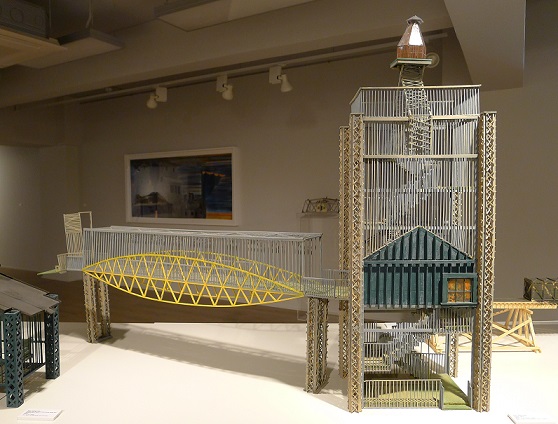藝評
取締乏味的石屎高架道路 ∣ Replacing Barren Concrete Overpasses
約翰百德 (John BATTEN)
at 12:08pm on 22nd April 2017


Caption:
1. & 2. Installation view of Siah Armajani's exhibition at Rossi & Rossi, Hong Kong
(Please scroll down for English version)
香港政壇的大事行政長官選舉終於落幕,未來五年的特首已塵埃落定。新政府現正籌劃交接工作。情況應該與此前大同小異,行政會議會加入幾張新面孔,但在後台主持大局的都是世代相傳的舊人脈。市民大眾可以聳聳肩然後繼續往前看,但在重要關頭,仍然可以對顯然的錯誤發聲,當政府過分養尊處優時,這種情況將無可避免地會出現。
另外剛結束的,還有每年都在香港亮相的藝展Art Basel Hong Kong。這次展覽讓香港會議展覽中心擠滿了國際藝廊、腰纏萬貫的收藏家、喜歡窺探藝術人士和宣傳、銷售與市務大員等這些經常在高檔活動中出現出席的人士。就像突如其來的風暴一樣, Art Basel來也匆匆,去也匆匆,之後香港的藝壇節奏又回復正常。
黃竹坑的雷·藝廊現正舉行一個匯聚政治與藝術角度的精彩展覽,將開放至4月中。西阿.阿瑪雅尼(Siah Armajani )於1939年在伊朗德克蘭出生,1960年移居美國,離開當時由伊朗國王統治,政治上壓迫的國度。離開祖家的經驗,影響了阿瑪雅尼的思想和藝術。展覽涵蓋藝術家過去60年來的努力,參觀者可以欣賞到他的畫作、建築概念模型、雕塑和近期的紙上創作。
阿瑪雅尼於明尼蘇達修讀哲學,並在明尼阿波利斯定居,更在當地對藝術高度支持的氛圍下設立工作室。阿瑪雅尼的興趣包括波斯詩詞、哲學,特別是自由意願和民主的政治意念,他並非常欣賞美國的本土建築。這些興趣投射到物件和建築空間上,通常都是對文學、哲學和政治人物致敬,並於公共空間展示。他的藝術作品不但具備雕刻之美,也饒富實用價值。他說:「我對高尚的實用性很有興趣。我的想法是建立開放可用、實際而可共同分享的公眾聚集地,一些充滿街坊人情味,讓人匯聚一堂的地方。」
他根據自己的設計以木、鋼、塑膠和其他物料製成模型。這些模型通常在稍後建成多種實際用途:由橋樑和樓梯組成的行人天橋系統、樓閣、涼亭和避雨亭、會面和進行社交活動,甚至是自我沉思的場地。這次展覽除了選出多個模型,也附以相關圖則。然而,阿瑪雅尼的模型並不只流於理論層面。他的建築模型都擁有實用的形態,並以藝術家的天真作點綴,讓人看到的不是建築師的作品,而是藝術家希望自己想出來的型態得以實現,成為人們真正可以使用的東西。他的意念植根於真實世界,並期望工程師和承建商可以讓這些意念成真,建成大型實物。
令人嘖嘖稱奇的是,他的建築意念大部份均有建成!他美侖美奂的橋樑橫跨繁忙的道路網,而他筆下的幽靜涼亭則在歐美各地的公園中出現。阿瑪雅尼的作品充滿啟發性。他的意念演化成公共藝術,既實用也富藝術氣質。親眼看到阿瑪雅尼的公共藝術作品是令人心曠神怡的事情。他的作品通常都放在荒涼的空間:沒有事情比踏上陡峭的樓梯,然後經一條乏味的石屎高架道路橫過下方急速嘈吵的道路更令人心感鬱悶。人性在這苛刻的環境下被矮化,變得毫無重要。難怪有人會選擇在類似地方結束自己的生命。但是阿瑪雅尼的樓梯和橋樑是美好生活與良好規劃的延伸。這些設計告訴人們:有人關心你的需要,即使那個人只是一位寂寂無名,在沒有個性的政府中工作的官員。
我們的建築環境反映建設者的思想。
只要一點點關愛,加上對藝術的欣賞和創意思維,香港充滿敵意的石屎空間可以稍為放輕鬆,為更美好的將來提供實證。我們也可以追隨阿瑪雅尼的靈感:難我們就不可以建設一些反道而行、天馬行空和非比尋常的行人高架橋,用來取代那些讓靈魂窒息、醜不堪言的石屎建築?
原文刊於《明報周刊》,2017年4月1日。
Translation from the original English by Aulina Chan.
Replacing Barren Concrete Overpasses
John Batten
In Hong Kong’s political sphere, the Chief Executive election is now over. It was a ‘done deal’, ‘fixed’ for another five years. The new administration is planning its succession to government right now. It will be more of the same with the addition of a few new faces in the Executive Council, but the same old faces in the back-rooms doing the deals and networking amongst themselves as they have done for generations. The general public can shrug and look on – but, at crucial moments, can still raise their voices at the obvious wrongs and mistakes that inevitably will happen when government like this gets too cosy and complacent.
Also, just ended, is the little storm that arrives every year: Art Basel Hong Kong, the yearly art fair that fills the Hong Kong Exhibition & Convention Centre with international art galleries and rich collectors, art voyeurs and the promoters, sales and marketing hangers-on that always mix at any high-monied event. And like a sudden storm, Art Basel disappears as suddenly as it came, and Hong Kong’s art rhythms return to normal.
Combining aspects of the political and art is an impressive exhibition now on at Rossi & Rossi art gallery in Wong Chuk Hang, running until mid-May. Siah Armajani was born in 1939 in Tehran, Iran and moved to the USA in 1960 – leaving behind the politically repressive Shah regime then in power in Iran; an experience that has influenced his thinking and art. In this comprehensive exhibition are drawings, conceptual architectural models, sculpture and recent works on paper covering sixty years of work.
Armajani studied philosophy in Minnesota and settled, setting-up a studio, in the supportive art environment of Minneapolis. His interests cover Persian poetry, philosophy - particularly political ideas of free will and democracy - and a strong appreciation for American vernacular architecture. These have been translated into objects and architectural spaces, often in homage to literary, philosophical and political figures and displayed in public places. His artwork is both sculptural and practical. He says, “I am interested in the nobility of usefulness. My intention is to build open, available, useful, common, public gathering places – gathering places that are neighbourly.”
He designs and then makes models from wood, steel, plastic and other materials; these are often later built for a range of practical uses: elevated walkways in the form of bridges and stairways, and pavilions, gazebos and shelters; places to meet, socialize or for solitary meditation. In this exhibition, a cross-section of models are on display, complemented by drawings. Armajani’s models however are not just theoretical ideas. His architectural renditions are practical forms, finished with a touch of artistic naïveté: the work of the non-architect, but an artist wishing his forms realized and of practical use for people. His ideas are rooted in the real word: with the hope that engineers and contractors build these ideas into a large-scale form.
And, amazingly, most of his architectural ideas are built! His fantastic bridges cross busy roadways and his quiet gazebos are placed in parks around the USA and in Europe. That is inspirational. His ideas are translated into public art that is both practical and artistic. It is spiritually uplifting to see Armajani’s public art. His work often fills spaces that are bleak – there is nothing more depressing than climbing a steep stairway to reach a barren concrete overpass to cross a road with speeding, noisy traffic below. A person, the human condition itself, is reduced to insignificance in such a harsh environment. It is no wonder that such places are chosen by some in which to end their lives. But Armajani’s stairways and bridges are an extension of good living and good planning – it says: someone cares, even if that ‘someone’ is an anonymous government official working in the name of a faceless government department.
Our built environment mirrors those that build it.
With just a little care, and appreciation of art and creative thinking, Hong Kong’s hostile concrete spaces can be loosened up to offer the physical proof of a brighter future. We too can follow Armajani’s inspiration: can’t we build some wacky, fantastic and unconventional pedestrian overpass bridges to replace the dreadful, concrete, soul-destroying eyesores we now have?
This essay was originally published in Ming Pao Weekly on 1 April 2017.
